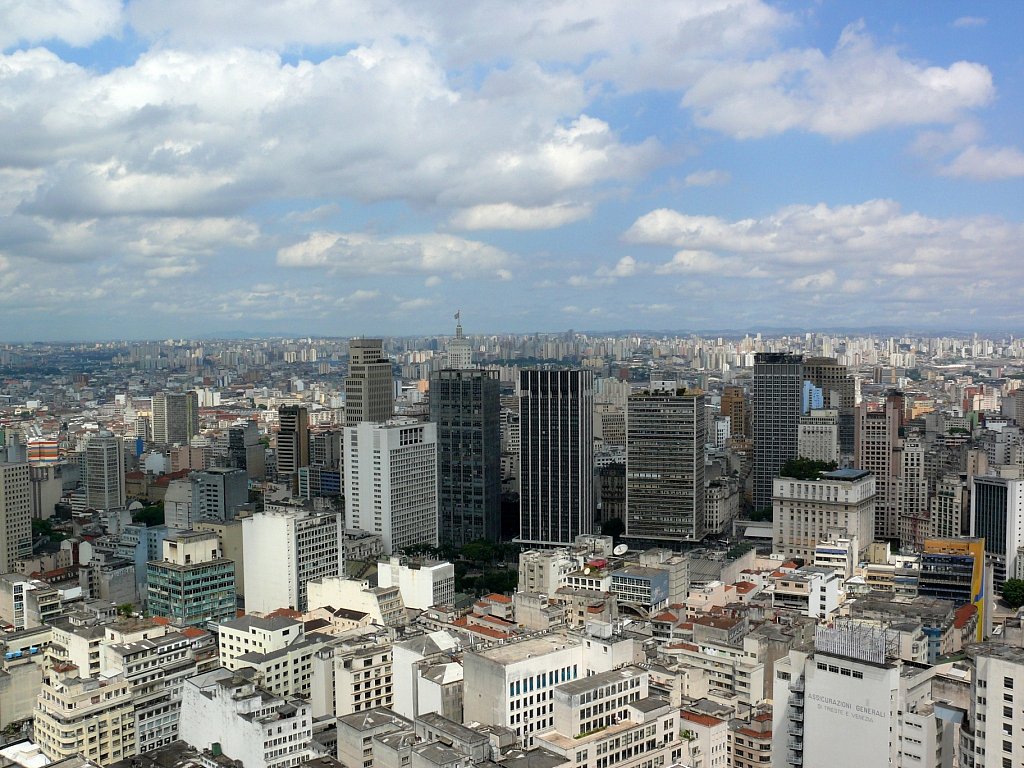
São Paulo cityscape © Veebruar, licensed Creative Commons Attribution.
Regardless of whether you plan to rent or buy a home, the issue of housing is a complex one for those planning a move to Brazil. This is because many factors that wouldn’t necessarily come into play in North America, or would be minor considerations, are major issues in Brazil. On a more macro scale, when choosing a potential neighborhood to live in, you’ll need to do some research into possible dangers and safety issues.Security, for instance, is a massive issue. For this reason, some expats—like many middle- to upper-class Brazilians—opt to live in closed condominium complexes, not just in urban and suburban centers, but even in smaller towns and coastal areas. Electric fences, 24-hour guards, security cameras, alarm systems, and indoor garages, not to mention windows with bars (grades) so that thieves can’t scale walls and break into houses or apartments, are all amenities that Brazilians consider when renting or buying a home. Unfortunately, you’ll need to consider some or all of them as well.On a more macro scale, when choosing a potential neighborhood to live in, you’ll need to do some research into possible dangers and safety issues. Even the most upscale urban neighborhoods fall prey to crime; after all, thieves know very well that that’s where all the spoils are located. Without becoming paranoid, it’s important to be aware of vulnerable areas. In many cases, safety issues will narrow down your choice of housing options considerably.
Another major consideration is the elements. While a bonus of living in tropical Brazil is the abundance of natural light that ensures you’ll never suffer from SAD (Seasonal Affective Disorder), you have to keep in mind that the closer you are to the Equator, the more brutal the effects of the sun’s rays. Lots of direct sun exposure can wreak havoc on objects and furniture, bleaching colors, fading photos and book jackets, and weakening fabrics. Depending on what time of day the sun hits, it can also turn your home into a miniature furnace. For this reason, many apartments, particularly in the Northeast, advertise themselves as nascente (rising) and poente (setting); these terms refer to the periods when the sun will cast its light and heat within your space. In general nascente apartments are cooler (since the rising sun is weaker), but if your bedroom is nascente, you’ll need to invest in serious black-out curtains. Poente means you may be treated to a magnificent sunset (if the horizon is unobstructed), but in the hours leading up to this spectacle, rooms facing the sun will heat up like ovens.
On the other hand, some direct sunlight is useful to combat humidity and moisture and to ensure freshly washed clothes get dry (driers are rare in Brazil). In tropical regions of Brazil, particularly along the coastline, it can get very humid, especially during the rainy season. As a result, you’ll find yourself battling enemies such as mold, mildew, and rust, which will attack everything from clothes and shoes to your favorite photographs. Living near the ocean complicates things even further because you’ll be subject to maresia. A common term in coastal areas, maresia refers to the oxidization caused by sea (mar) water that leads to gradual corrosion of all metallic objects. Over time, it can wreak havoc on computers, sound systems, and other types of electrical equipment and appliances.
Only a few years ago, back when the exchange rate was very favorable for North Americans and Europeans and before Brazil’s economic boom kicked in, buying real estate in Brazil was an amazingly good deal and buying land was incredibly cheap. Those days, however, are gone.
In 2011, the Brazilian real was considered the most overvalued currency on the planet (it has since fallen somewhat; from R$1.6:US$1 in 2011 to R$2:US$1 in early 2013). However, a combination of political and economic stability, rising incomes and purchasing power, an emerging middle class eager to buy, and the unprecedented availability of credit have all resulted in a booming construction segment and skyrocketing real estate markets throughout Brazil. Between February 2011 and 2012, the average asking price for apartments in Brazil increased by 24.8 percent according to the FIP ZAP Index of dwelling price offers. During the same time period rents in São Paulo and Rio rose by 12.6 percent and 20.2 percent, respectively.
The upshot is that both purchasing prices and rents for new and used apartments are both much more expensive than they were five years ago. That said, buying prices have actually soared higher than rents; between 2008 and 2012, average real estate prices in Brazil jumped by 129.5 percent while average rents only rose by 68.4 percent. Although, in 2012, Brazil’s economic slow down has seen prices soften a little, experts feel that values will not only continue to rise but to overheat. Some even predict the creation of a housing bubble that, at some point in the future, could burst. As such, these days most specialists concur that it makes more economic sense to rent than to buy.
Excerpted from the First Edition of Moon Living Abroad in Brazil.